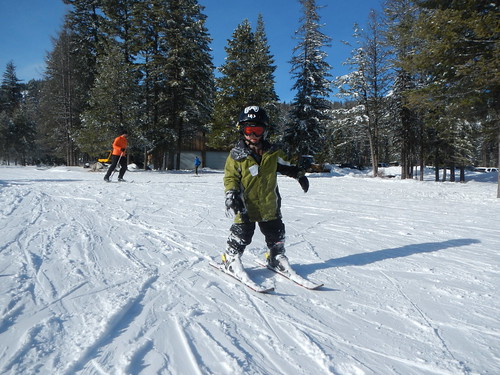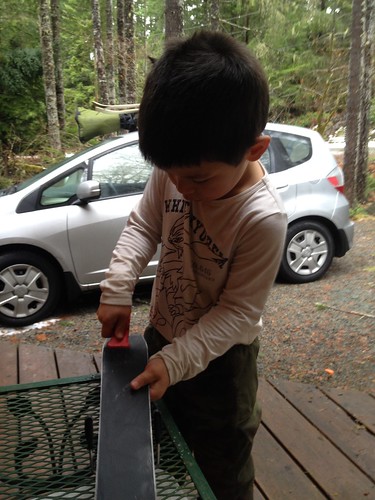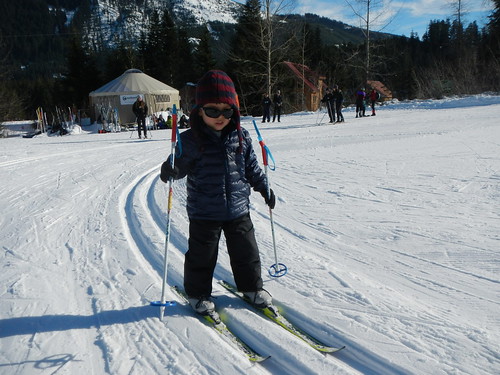Sizing Ski Gear for Kids
 Every year I find myself on a treasure hunt across the city looking for ski gear for the kids. The boys have little patience for standing around as I rummage through gear at the ski swap or second-hand inventory at the local shop--inevitably I find them in a wrestling match in a pile of used boxing gear while I am trying to check sizing on skis.
Every year I find myself on a treasure hunt across the city looking for ski gear for the kids. The boys have little patience for standing around as I rummage through gear at the ski swap or second-hand inventory at the local shop--inevitably I find them in a wrestling match in a pile of used boxing gear while I am trying to check sizing on skis.I have found that a better approach is to get the kids to stand up in the kitchen, mark their height, and record the measurement in my smart phone. I record their weight and shoe size too. Then I figure out what size gear they need and record all that in my phone too. With sizing information in hand, I can figure out what gear they will need and put together my shopping list. The tables below have been assembled from multiple different sources and some of my own experience (I could not find any source that had everything all in one place). This information should be considered a starting point. As kids get older, individual body types develop, and skills mature, you will develop more experience in shopping for gear.
Nordic Ski Sizing

First convert the height of your child in inches to cm (conversion utility)
For classic skis target 115% of height with a range of 110-120% of height.
For skate skis target 108% of height with a range of 106-110% of height. Be sure not to go too long with kids who are just learning to skate--they need to be able to pick the ski up for each forward stride. But go too short and you compromise on glide.
You can adjust this range based on age and experience:
- 3-5 years old: Go with shorter classic skis that are closer to 100% of height. Waxless skis are the best choice.
- 5-8 years old: Select classic skis between head height and the height of an outstretched wrist (shorter end of this range for beginners and longer end of the range for those who have been skiing for a couple years). Waxless skis are recommended.
- 8+ years old: Select a ski length that is roughly equal to the height of an outstretched wrist for classic skis and about 10cm shorter for skate skis. Kids can begin to take part in the waxing process at this age but waxless skis are still a simple choice for classic skis since they require understanding the more complicated principles of both glide wax and kick wax.
Ski camber (the upward arch of the ski in the middle) or its resistance to flattening when weighted is also important to consider particularly as children grow older and their body type develops. A softer flex is best for those who are light relative to their height while a harder flex is necessary for those who are heavier relative to their height.
- Classic skis have more pronounced camber to keep the grip wax pocket (or in the case of waxless skis the fish scales) off the snow during glide but engage it during the kick.
- Skate skis tend have less camber and tend to be stiffer. If the flex is too soft you will "bottom out" and not glide as smoothly. If you do not have enough flex, too much of your weight will be on the tips and tails of the skis.
Alpine Ski Sizing

Ski length should generally be between the chest and the nose. Choose a ski at the shorter end of the range for a novice or a skier who is slightly lighter than average for his height. Choose a ski at the longer end of the range for a faster and more aggressive skier or one who weighs more than average for his height. Carry a metric tape measure with you to the ski swap or local used sporting goods store in case the size is not printed on the ski.
| Skier Height (in) | Skier Weight (lbs) | Ski Length (cm) |
|---|---|---|
| 37 | 34 | 70-80 |
| 40 | 37 | 80-90 |
| 43 | 42 | 90-100 |
| 45 | 46 | 95-105 |
| 47 | 50 | 100-110 |
| 50 | 57 | 110-120 |
| 53 | 63 | 115-125 |
| 55 | 70 | 120-130 |
| 57 | 79 | 130-140 |
| 59 | 89 | 135-145 |
| 61 | 100 | 140-150 |
| 65 | 112 | 150-160 |
Ski Boot Sizing

I find you need to get the kids to actually try the boots on as fit really does differ between brands, and in many cases with used gear the size label has rubbed off.
Alpine boots are typically sized using Mondopoint which is the length of the foot in cm (sometimes expressed in mm so 22.5cm is the same as 225mm).
Nordic boots typically use European shoe sizing where each unit is a Paris Point equivalent to 2/3 of a cm. I always go with NNN boots and bindings as it seems you can find more inventory when looking through used gear. Nothing wrong with SNS if you come across boots that fit well and the right length of skis with SNS bindings. Note that boots for classic and skating are different as you want more flexibility for classic and more stability for skating. The skate boots have more ankle support and stiffer soles. Combi boots offer a compromise between the two, but I generally don't recommend trying to skate with a low cut classic boot or trying to ski classic with a skate boot. Skiing with the wrong style of boot makes it harder to control the ski resulting in a less enjoyable experience.
| US Kids | US Men's | US Women's | Alpine Mondopoint | Nordic Euro |
|---|---|---|---|---|
| 8 | . | . | 15 | 25 |
| 9 | . | . | 16 | 27 |
| 10 | . | . | 17 | 28 |
| 11 | . | . | 17.5 | 29 |
| 12 | . | . | 18.5 | 30 |
| 13 | . | . | 19.5 | 31 |
| 1 | . | . | 20.5 | 32 |
| 2 | . | . | 21 | 33 |
| 2.5 | . | . | 21-21.5 | 33-34 |
| 3 | . | . | 21.5 | 34 |
| 3.5 | . | . | 21.5-22 | 34-35 |
| 4 | . | . | 22 | 35 |
| 4.5 | . | . | 22.5 | 36 |
| 5 | 5 | 6.5 | 23 | 37 |
| . | 5.5 | 7 | 23.5 | 37-38 |
| . | 6 | 7.5 | 24 | 38 |
| . | 6.5 | 8 | 24.5 | 38-39 |
| . | 7 | 8.5 | 25 | 39 |
| . | 7.5 | 9 | 25.5 | 40 |
| . | 8 | 9.5 | 26 | 41 |
| . | 8.5 | 10 | 26.5 | 42 |
| . | 9 | 10.5 | 27 | 43 |
| . | 9.5 | 11 | 27.5 | 44 |
| . | 10 | 11.5 | 28 | 44-45 |
Ski pole sizing:

For alpine poles, turn the pole upside down and grab it under the basket (the side opposite the tip). Your lower arm should be parallel to the ground. A novice can go a little longer and an advanced skier can go a little shorter.
For nordic poles, extend your arm parallel to the ground. The pole should come up to the underside of your arm pit. Novices can go a little shorter and advanced skiers who raise their arms higher can go a little longer.
Carry a metric tape measure with you to the ski swap or local used sporting goods store as the size is not always printed on used gear.
| Skier Height (in) | Alpine Pole (cm) | Nordic Pole (cm) | Nordic Skate Pole (cm) |
|---|---|---|---|
| 38 | NA | 80 | 90 |
| 39-40 | 80 | 80 | 90 |
| 41-43 | 85 | 85 | 95 |
| 44-45 | 85-90 | 85-90 | 95-100 |
| 46-47 | 90 | 90 | 100 |
| 48-49 | 90-95 | 95 | 105 |
| 50-51 | 95 | 100 | 110 |
| 52-53 | 95-100 | 100-105 | 110-115 |
| 54-56 | 100 | 105-110 | 115-120 |
| 56-57 | 100 | 115 | 125 |
| 58-59 | 100-105 | 120 | 130 |
| 60 | 105-110 | 125 | 135 |
| 61 | 110 | 125 | 135 |
| 62 | 110 | 130 | 140 |
| 63 | 110-115 | 130 | 140 |
| 64 | 115 | 135 | 145 |
| 65 | 115 | 135 | 145 |
| 66 | 115-120 | 140 | 150 |
Labels: Kids in the Outdoors, ski

<< Home